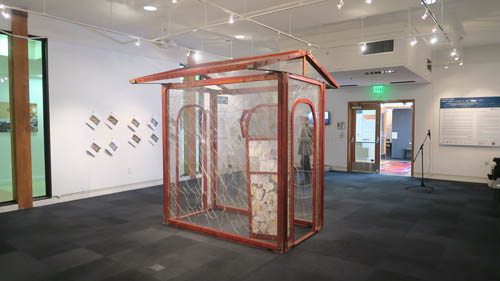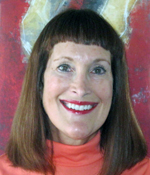
By Mimi Pollack

SAN DIEGO — I walked into the exhibit at the New Americans Museum at Liberty Station with no intention of writing a story. I was just there as a guest at the opening reception of Project Vision. However, the exhibit moved me so much that I changed my mind. As an ESL teacher who has worked with many Sudanese refugees, how could I not tell the story of the 8,000 paper clips?
The Israeli sculptor and TED fellow 2010, Raffael Lomas, has a new exhibit called, “8000 Paper Clips and One Skype Call.” It is an artistic encounter between the artist and some South Sudanese refugees who were deported from Israel to Southern Sudan, and are now living in Uganda. The exhibit is basically a wooden house frame with 8,000 paper clips as its walls. The house was a way for Lomas to do a project and connect with the children while telling their story. It includes a very interesting 30 minute film by filmmaker, Nitsan Tal, which explains how the project came about.
It is also about how artistic endeavors can bring about social change. In this exhibition, Lomas explores what he calls, “social practice.” The curator, Olga Sureda, defines it as, “A practice that could be defined as socially engaged art, developed through collaboration, participation, dialogue and immersive experiences.
She goes on to explain that, “The exhibition acts as a multi-medium guide to express the story of the project, and a glimpse into the life of a refugee, with the aim to emphasize the barriers that have been broken during the project in its entirety.”
As Linda Caballero-Sotelo explains, “The exhibition is a lens into the global issue of human displacement, deliberate and/ or forced. The 8,000-paper-clip house is a metaphorical home, constructed of the simplest materials, paper clips, as a reminder of the fragility, but nonetheless resilience of the human spirit in its quest to build a better future…”
Lomas wanted to find a concrete way to help the Sudanese who were deported to Southern Sudan. Some of the children had been born in Israel and it was a complete shock to them to return to their “home country” when they considered Israel to be their home.
Because Southern Sudan was still in so much turmoil, many of the children did not go to school, so about 100 children, who mostly spoke Hebrew, were sponsored by the Israeli foundation, Come True, so they could attend boarding school in Kampala, Uganda.
In the summer of 2014, Lomas and his team went to visit them in Uganda. They worked with the both the students of the NIAAD Academy and other deported children, and collaborated on making the paperclip house together.
As Osvaldo Romberg, senior curator of the Slought foundation in Philadelphia puts it, “This project demonstrates the generosity and social engagement of Lomas’s artistic endeavors…. The project manages to be a humble gift to the children living in Kampala and to the refugee community in Tel-Aviv, as well as an unquestionably strong critical statement aimed at the current Israeli leadership who failed to take responsibility for its actions towards the community of political immigrants and guest workers.”
Hopefully, Lomas’s Project Vision and the foundations that helped, including Come True, Inspiration, and Brit Olam will have a positive impact on the lives and futures of these Sudanese children.
The exhibit runs through August 25 at the New Americans Museum in Liberty Station.
*
Pollack is a freelance writer based in La Mesa, California. She may be contacted via mimi.pollack@sdjewishworld.com. Comments intended for publication in the space below MUST be accompanied by the letter writer’s first and last name and by his/ her city and state of residence (city and country for those outside the United States.)